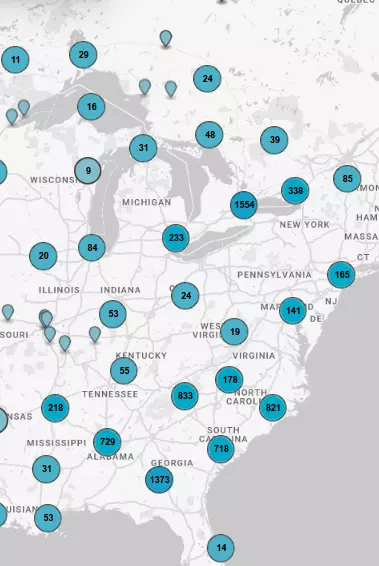HOLLENBERG RANCH PONY EXPRESS STATION
HOLLENBERG RANCH PONY EXPRESS STATION This building, constructed in 1857 by G.H. Hollenberg on his ranch here on the Oregon Trail, was a station on the Pony Express route in 1860-1861. It is...
- kshs
- kansas
EL CUARTELEJO
EL CUARTELEJO Reconstructed here are the remains of a seven-room pueblo believed to have been built by Pueblo Indians from New Mexico. According to Spanish records Indians from Taos and...
- kshs
- kansas
MARAIS DES CYGNES MASSACRE
MARAIS DES CYGNES MASSACRE Nothing in the struggle over slavery in Kansas did more to inflame the nation than the mass killing which took place May 19, 1858, about four miles northeast of...
- kshs
- kansas
WAGON BED SPRINGS
WAGON BED SPRINGS About two miles west were the Lower Springs of the Cimarron, an oasis in dry weather, where shortcuts of the Santa Fe trail converged to continue up the river. The most popular...
- kshs
- kansas
THIS GATEWAY TO KANSAS
THIS GATEWAY TO KANSAS Where the Kaw river joins the mighty Missouri in its sweep eastward, has witnessed many events of historical significance to this area, among them: 1804. Lewis and Clark, on...
- kshs
- kansas
- lewis and clark
AMERICAN INDIANS AND THE BUFFALO
AMERICAN INDIANS AND THE BUFFALO For thousands of years American Indians depended upon the buffalo for food, materials for shelter, and numerous other necessities.This relationship ended...
- kshs
- kansas
ELLSWORTH THE COWTOWN AND FORT
ELLSWORTH THE COWTOWN AND FORT When the Union Pacific built through here in 1867 this was buffalo country. As the engines chugged on west, the Hays newspaper reported: 'Passengers on the cars...
- kshs
- kansas
EL CUARTELEJO
EL CUARTELEJO To escape Spanish oppression, a group of Indians from Taos Pueblo left their home in New Mexico and settled in what is today Scott County. Here they lived alongside the Kiowa Apaches...
- kshs
- kansas
ARKALON AND THE SAMSON OF THE CIMARRON
ARKALON AND THE SAMSON OF THE CIMARRON Many Kansas towns originated as potential railroad centers. Three miles west of this marker Arkalon was founded in 1888 at the Cimarron river crossing of the...
- kshs
- kansas
KANSAS - THE WHEAT STATE
KANSAS - THE WHEAT STATE For centuries Kansas was the home of Native Americans who benefited from the richness of the region: vast herds of buffalo on the plains, deer and other game in the...
- kshs
- kansas
THE LAND OF QUIVIRA
THE LAND OF QUIVIRA The Wichitas once populated southern Kansas. They lived in villages of cone- shaped grass lodges, growing crops for food and trade. In the fall and winter they headed west...
- kshs
- kansas
THE SANTA FE TRAIL
THE SANTA FE TRAIL Cimarron, settled in 1878, got its name as the starting point at one time of the shorter Cimarron or dry route to Santa Fe. Here the Santa Fe divided, one branch heading...
- kshs
- kansas
GEODETIC CENTER OF NORTH AMERICA
GEODETIC CENTER OF NORTH AMERICA On a ranch 18 miles southeast of this marker a bronze plate marks the most important spot on this continent to surveyors and mapmakers. Engraved in the bronze is a...
- kshs
- kansas
OLD RUNNYMEDE
OLD RUNNYMEDE Two miles northeast of here , in 1890, stood a typical English village. Curving driveways led to English-style houses set among rows of clipped hedges. Nearby were polo grounds, a...
- kshs
- kansas
TURKEY RED WHEAT
TURKEY RED WHEAT Children in Russia hand-picked the first seeds of this famous winter wheat for Kansas. They belonged to Mennonite Colonies preparing to emigrate from the steppes to the America...
- kshs
- kansas
BATTLE OF THE SPURS
BATTLE OF THE SPURS One witness to this event later wrote that it was “no joke” to attack old John Brown. The abolitionist inspired such terror that in January 1859, about 1.5 miles north of here,...
- kshs
- kansas
BATTLE OF HICKORY POINT
BATTLE OF HICKORY POINT In September, 1856, a band of Proslavery men sacked Grasshopper Falls (Valley Falls) and terrorized the vicinity. On the 13th, the Free-State leader James H. Lane with a...
- kshs
- kansas
SANTA FE TRAIL RUTS 1821-1872
SANTA FE TRAIL RUTS 1821-1872 Looking east, up and over the bank of the ditch, one can see the wagon ruts of the Santa Fe Trail. You will notice a difference in the color and texture of the...
- kshs
- kansas
CANNONBALL STAGE LINE HIGHWAY
CANNONBALL STAGE LINE HIGHWAY Flamboyant and colorful, Donald R. 'Cannonball' Green (1839-1922) ran a stage line connecting the railroad to towns across southwestern Kansas. Green started...
- kshs
- kansas
FORT LEAVENWORTH
FORT LEAVENWORTH Established in 1827, Fort Leavenworth is the oldest army post in continuous operation west of the Missouri River. Serving as the army's chief base of operations on the...
- kshs
- kansas
